Text
KEEPER: Post Production
30 days sitting in a dark room, listening to the same sounds over and over with only a Tesco meal deal for sustenance: this is the way of the sound designer.

So I went a little mad… A week ago I would have insisted that the sound design was terrible, but now, with hindsight, I don’t hate it. I think all things considered the dialogue is pretty clean, with the exception of ‘Water Break 2’, although I kind of knew this when I recorded it, and luckily the dialogue is not the most important part of this scene. Other than this, the style of KEEPER meant that I was unable to do a proper checkerboard dialogue edit. Any tiny issues that might be in the dialogue are covered by loud ambiences.
I enjoyed choosing between boom and lav for different scenes. In the final mix, most of the dialogue is from the lavs which, for me, heightens the observational, docudrama approach we were attempting. The sound quality is so different from anything I’ve done before where I’ve always favoured boom over lav.
I’ve managed to get it to a point where nothing is glaringly bad. My primary concern is whether or not it carries the right momentum (from the keeper drill to game scene especially), and whether it’s conveying the story in the best way possible. I can’t tell if I’m just too close to it or if the pacing is a bit weird.
There were a couple scenes that just never seemed to sing. When Graham pulls Aaron to one side and yells at him, his voice is not as ‘loud’ as I’d like it to be. Even though there’s a lot of signal coming through it doesn’t quite pack the punch I want it to. Similarly, the walk out into the pitches. It doesn’t quite hit in the way it should but I’ve been back over it a hundred times and I can’t figure out what’s wrong with it. Also, embarrassingly, sync was an issue, so there are improvements to be made in workflow. If I had time to revisit it, I’d like to ADR some more breaths and efforts with the cast.
I think the tone really comes across. The sound always feels quite natural, especially in the scenes which bookend the film: Will’s arrival at the club, the first changing room scene, the last changing room scene and Will leaving the club. I think these scenes are actually really clean. All the footsteps and movements from the wildtracks are subtly integrated and completely believable. The action scenes were always going to be more difficult - trying to strike a balance between drama and naturalism; heightening the impacts but never pushing them into melodrama. I’m not sure I’ve quite achieved it but it’s nearly there.
Here’s a google drive link to all the notes I took during the designing and mixing process.
4 notes
·
View notes
Text
KEEPER: Production
The shoot ran fairly smoothly. Here’s a run down day by day!
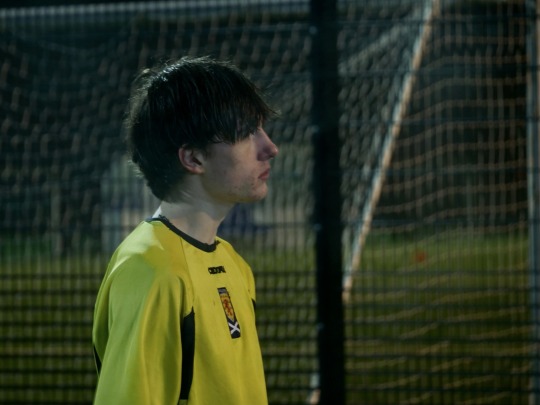
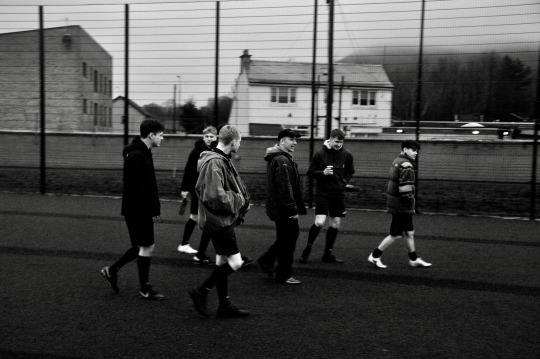
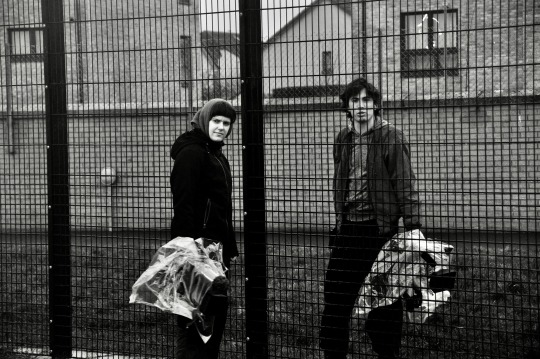
Friday - Changing Rooms
The prep we did during the tech recce really helped here. I was able to tell Tom exactly where he should boom from without having to consult camera. We did eventually need to consult camera to check exact edge of frame, but the prep definitely streamlined our communication.
Saturday - day off!
Talked about the shoot with Ben.
Sunday - Will’s Bedroom
A lot of time spent basking in the sun on the decking at Jake’s, waiting for the light to change. It was an indoor location where we had full control so it was fairly easy for sound. Only challenge was space. The room wasn’t very large and we (Tom and I) had to hide in a corner behind camera. When I wasn’t soaking up the sun, I was hiding in a cupboard next to an unnerving pillow of Jake’s face.
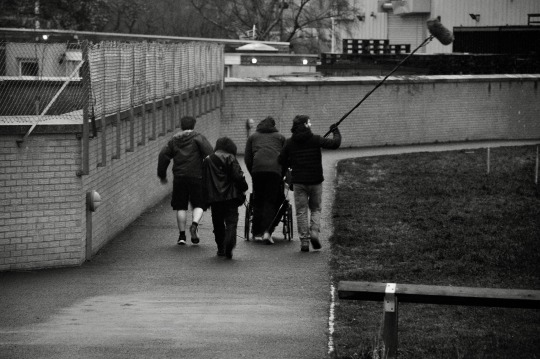
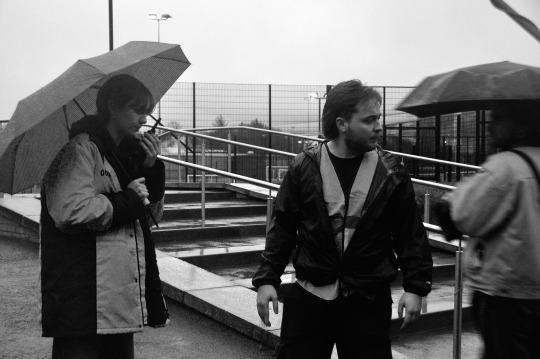
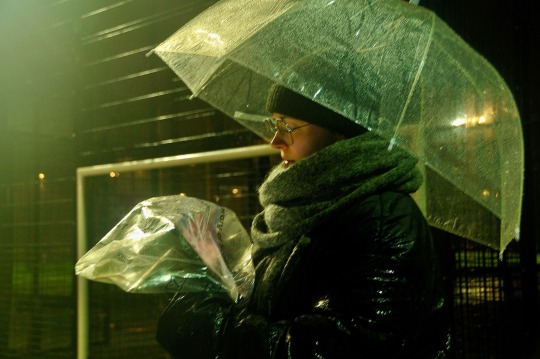
Monday - 1st Pitch Day
So rainy! The weather made communicating anything ten times harder, and it was our first day out on the pitch so we were still settling into the environment. To make it all just slightly more complicated, we switched around the schedule so we were basically shooting in sequence. It was necessary to move all of scene 5 onto this day to minimise continuity errors, however it did create some confusion. I hadn’t really prepped to shoot those scenes on that day so it kind of put us on the back foot. This being said, we still got everything shot and only wrapped slightly late.
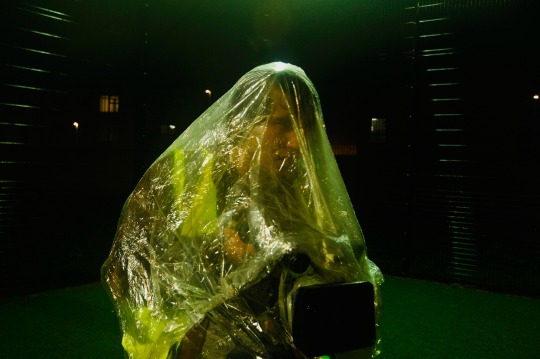
Tuesday - also a day off!
Had crew dinner at Nando’s and conversations with Ben about the direction of the film so far - what beats we were already hitting, what might need adapted. With our style of shooting, there was room for some flexibility. Was also able to speak with Zoe at SAS about how sound was going. Came up with a strategy with Alex and Ben for how we would better communicate over the next two days on set.
I’ve never been able to reflect on a shoot whilst it was happening before and I was surprised at how valuable I found this day off. Such a shame that I’ll probably never have the luxury again!
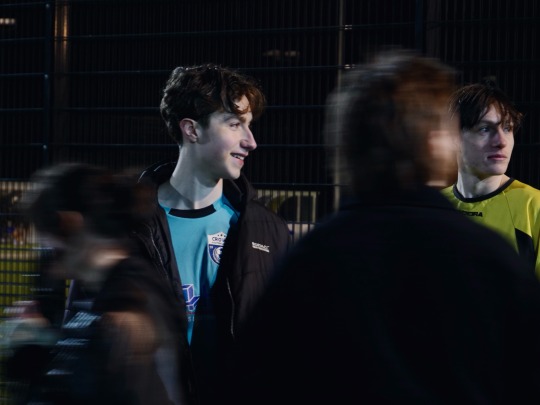
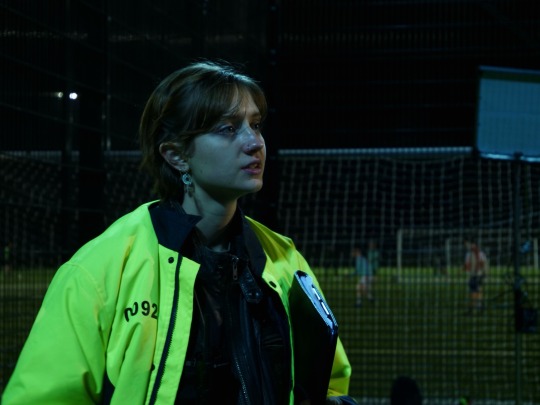
Wednesday - 2nd Pitch Day
Ran much smoother. No huge issues, except that Monday’s shoot had made me ill. :((
Slightly concerned about the sound for water break 2 - the boom couldn’t be close at all and I couldn’t get LAVs on them, since it’s a continuous take from the scene before.
Tom continued to be an incredible boom op through very, very long takes in the freezing cold! I was very grateful!
Thursday - 3rd Pitch Day
Last day ever on a set in uni! People cried! Unusually, not me!
Also ran smoothly. Re-shot the walkout shot from Monday. Sound was good, probably the best of the three days. Had a chance to get some extra field tracks of the ambience.
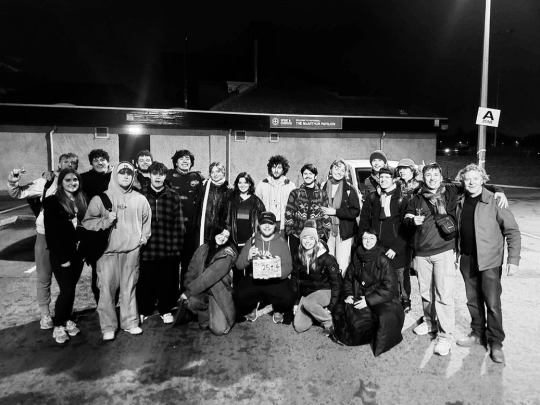
In the end, sound wasn’t actually forced to compromise much at all. There were a lot of factors which we couldn’t always control and that was scary, for sure. The improvised dialogue, improvised movements, the loud, inconsistent, constant background noise, the weather, the broken/missing kit (two crackly radio mics and no waist bands!) - it was all against us and yet there were no real catastrophes, which shows how much my sound recording has improved in the past two years.
At times the stress got the better of us (mainly me, maybe Alex) but on the whole, the set was extremely professional and well run. I really enjoyed being able to focus entirely on sound recording, which never really seems to happen on student projects. I just loved working with this team! Everyone was firing on all cylinders and I could trust that everyone was doing their jobs amazingly and just focus on my own sound shit. I still had my overstepping, control-freak moments but they were significantly reduced.
It was so cool to see it all come together from pre-production. I’m so proud of everyone and grateful for all the work they put into this film!
5 notes
·
View notes
Text
TSM&M: Post Production

This was my first ever 5.1 mix so all things considered I guess it could be worse. Out of the two mixes this one is definitely more playful but probably less polished. We didn’t do as much sound prep for this film compared to Keeper, and it began to show in the design when we found ourselves with gaps that we were unsure in how to fill. For instance, the Mira dolly shot towards the end - the idea for that scene was borne out of the sound design process, and we didn’t have a plan for a very long time.
The dialogue is messy and inconsistent. There are some weird frequencies in their voices in certain shots and I hate it. Ugly, bad, ew. Every scene has one line that just sounds fucked. And I tore my hair our trying to correct it, and I couldn’t figure it out so I did the best I could. It’s a mixture of lav and boom throughout, mixed differently depending on the scene - for example, I used more lav in the projection room since the background noise was so loud. There are scenes where I can still hear the dialogue dropping in and out. It’s just not great.
I’m much happier with the rest of the sound. If nothing else, it’s fun. There’s a good pace and energy to a lot of the scenes which I really enjoy. I think the level of reality, or hyper reality is potentially a bit confused, in the sense that I’ve pushed some things quite far and then been quite restrained with others. I’m not sure if it’s entirely consistent.
Reverbs created a lot of issues for me. I’m used to the Space plug-in - I like the sound of it and I’ve got a basic grasp on the settings. However, it’s a little janky to use in 5.1. You have to create a stereo aux, and then select the stereo > 5.1 version of the plugin and then route using the stereo sub-paths, and it’s a big faff and you can’t pan the reverb. The alternative is ReVibe which allows for panning, but I couldn’t understand the settings and any outcome just felt artificial.
Although I’m slightly disappointed with the outcome, I learnt a lot. I’m not very experienced with dialogue edits so it’s not that surprising that it’s kind of mediocre. Before this year I didn’t know anything about loudness or even really understand compressors or limiters and I’ve finally figured out how to use them. So I guess that’s win.
1 note
·
View note
Text
TSM&M: Production

Tom was the best boom op! That dolly shot at the start was such a complex boom manoeuvre and we managed to get every line of dialogue we needed! (We won’t mention the boom shadow.) Alongside the 416, I was also using a stereo recorder from The Film Cult as a back up microphone. It captured Mira’s lines while she was facing the wall, I also used it for atmoses, that sort of thing. And then I had radio mics on the cast throughout the shoot, held in place with Tom’s safety pins and a bit of electrical tape.


As previously explained, the day of simultaneous ADing and sound recording was particularly rough, but every day brought its own stresses. We were quite late leaving set every day and kit pick up/drop off was a nightmare. The cast were always in high sprits though which definitely helped boost morale, and exploring the Filmhouse was fun.
As well as the posters I made for the Filmhouse, I did a bit of production design for the flat location with Ben (see the microwave/bin/coffee mug setup in the photo above). Sadly it never made it to the screen :(
1 note
·
View note
Text
KEEPER: More Shoot Prep
Before we started shooting, I sat down with Ben and Alex to figure out the boom position for every setup. We discussed the action and blocking of each scene and based on this, I figured out where I could use radio mics and when I wanted to use the stereo mic we rented from The Film Cult. I collated this information with the sound breakdown I did earlier into one document: linked here.

As we were shooting I continued to update it. For example, the weather on Monday made it difficult to use the stereo mic without fear of breaking it, so I decided it wasn’t worth the risk. You can see these notes are greyed out. Having it all in one document to refer to made everything so much simpler on set. I knew what wildtracks I needed and could tick them off if we covered them in takes. Every conversation with camera was more streamlined, I only had to check how we were deviating from the plan, rather than figure everything out from scratch. I knew when I needed to get radio mics on the cast and when they had to be removed.
0 notes
Text
Saint Catherine’s
I wasn’t an official role on set, I wasn’t really supposed to be there, I just wanted to go on holiday with my friends. At one point I was maybe going to (hesitantly) boom op but luckily they found George so I came on as BtS/Stills photographer for two days instead. And it was so fun! I loved it. Even when the toilet broke and the boiler was on the brink. Loved it. My friends are so clever and talented! Orla and Katie are the loves of my life! <3 Ok, gush over.
Here’s some photos, digital and film, and an iPhone pic of Craigie being Craigie.










5 notes
·
View notes
Text
Anna and TSM&M: 1st ADing and the art of multitasking




Pretty last minute I came onto Anna as 1st AD for the Limekilns location. Tom had already made a rough shooting schedule but once we got on set, we realised it made sense to re-jig a couple of things to streamline the day. Unfortunately, there were a couple of shots that had to be cut for time, which really annoyed me. As 1st AD it should be my job to make sure that everyone is moving along quick enough to meet the schedule. So yeah, annoying. It kind of put me off ADing a bit. On the plus side, it was a really fun set! Loved working with Tom as a director!
Due to unforeseen circumstances, I also recorded sound for a couple shots and boom op-ed for one, hence the headphones get-up in the picture above. This turned out to be good practice for the TSM&M shoot, when I had to simultaneously sound record and AD for one of the days. Wouldn’t recommend. You’re essentially just doing two jobs to a very mediocre standard.
ADing for TSM&M was stressful. If I’m honest, me and Robbie were probably doubling as on-set producers as well since Hollie couldn’t be there, so there were constantly 101 things to think about. It helped that I’d made the schedule as I had no one to blame but myself. Didn’t like what the stress did to me. Was very grateful for Ben and Mon on the other days so I could focus more on sound.
2 notes
·
View notes
Text
TSM&M: Pre-production
(Sound Specifically)

Similarly to Keeper, I created a sound breakdown for Mars which I’ve linked here. I felt slightly unclear on the sound of the world and the tone we were going for, so decided to dissect the script with Robbie and talk through what he was hearing - the answer was usually “music”. We had a look at some composers but I didn’t really like any of them and ultimately Robbie preferred pop music. I basically left him to it.
To free up more time in post I decided to design several elements of the soundscape ahead of shooting. I already had a rough emulation of the ‘Star Gate’ sequence which I used for the test shoot. I tweaked it a little and added some MIDI instrumentation (choral voices) with Alex’s help.
I identified three other elements I could record and design before the film was shot: the radio broadcast, the sound of 2001 (which Zoe suggested I could situate so it sounded like it was coming though the walls from the auditorium, leaking into the other spaces), and the rocket launch to Mars. For all of my recordings I just used a Sennheiser 416 in a quiet room.
2001 Emulation:
First, I sourced a bunch of license free aggressive room tones from Soundly to make up the ambiance. I also found some cool old fashioned sounding alarms which appear towards the end of the scene. Then, I recorded Alex and Robbie recreating the lines of the iconic “open the pod bay doors” scene - Alex as Dave, Robbie as Hal. I used EQ and Space to muffle their voices and adapted my ‘cinema speaker’ plug in settings from the test shoot to make it sound like the film was coming from, well, cinema speakers.
Rocket Launch:
Mainly made from license free stuff I sourced - low rumbles, engines, wind with heavy EQ, and radio static. Again, I recorded Alex and Robbie and myself for the voiceover. The script is based on a bunch of NASA and Space X launch videos I watched on YouTube.
Radio Broadcast:
My big break! I wrote a quick script and recorded my own voice as the radio presenter of indie.fm. Can’t wait to cringe in the screening! Put on a bit of a radio presenter sass and then pitched it down slightly in Pro Tools. Used EQ to make it sound like a old radio (harsh high and low pass) and saved the settings so I could import them into the main session later and apply the same affect to other sections of dialogue, music etc.
I also saved a bunch of other sound effects I liked from Soundly and Freesound such as an old telephone ringing, a projector, a few different radio sweeps - all analogue and retro sounding to suit the nostalgic theme of the film.
1 note
·
View note
Text
TSM&M: Pre-production
(Extra Curricular)

In the early days, before we got a producer attached, I helped Robbie with a few producing things. I also wrote the shooting schedule based on Aimee and Robbie’s shot list, attached here. Initially there were a few too many shots to feasibly shoot in the time we had, so Robbie and I cut them down to the essentials. We were also working around actor availability which proved an absolute nightmare. Most of the schedule had to be planned around when the actors could make it which resulted in some unusual days, skipping from location to location. Here’s some scribbled notes on the shot list:




About a week before the shoot we were informed that we wouldn’t be able to use the house lights in the auditorium as we had for the test shoot because they were broken. To try and come up with a plan, Robbie and I consulted other cinematographers on the course. For instance, we met Sam at Meadowhall and he talked us through what his approach would be. Below are some of his notes. Robbie also arranged to talk with Andrew.


To use the foyer within the filmhouse we had to go and clean it a week or so before. This was a good chance to do an additional recce before we started shooting. We decided where the green room would be, where we could store kit during the day and so on. In lieu of a production designer I also took rough measurements of some of the posters so I could go home and create some of our own to replace them. Since they were never going to be the focus of a shot I mocked them up on Canva very quickly. They consist mainly of inside jokes and my crappy illustrations.
2 notes
·
View notes
Text
KEEPER: Test Recce
After we decided on Peffermill as our location, we decided to go on a tech recce. I took a microphone, mixpre and contacts mics to test the sound. Here is a link to the notes I took on our tech recce - I have briefly summarised in this blog post.


Firstly, the changing room. Alex and Ben mapped out the blocking then, once Alex had finished testing lights, we figured out where I could boom from so we would never be creating boom shadow or risk accidentally dropping into frame on either of the two cameras - not an easy feat. One positive of this approach was that there would only be one setup for each changing room scene - once I knew my position, I was sorted.
Alex, Ben and I talked through each scene in detail. I made a note of any sounds I knew I would be missing on the boom and therefore wanted to cover in a wildtrack. I also noted down the position - or possible positions - of the other mics, e.g I knew I wanted a stereo mic pointing into the room to pick up the general movements; I had extra lavs at my disposal and, had we struggled to boom on the day, we could have planted a lav in the ceiling.
The contact mics were a bit of a fail. I tested them out on the metal benches in the changing room and the metal cages around the pitches but they didn’t pick up anything that I liked so I decided we wouldn’t use them for the main shoot.
Outside, in amongst the pitches, I was astounded by the noise. Our previous recce was earlier in the day and a lot quieter. To make sure that it would still be possible to record clean-ish dialogue I recorded a sample take of Ben talking, first up close and then from a distance, at different volumes. A few days later, in screen academy, I brought the recording into Pro Tools and messed about adding ambience underneath, adding noise reduction etc. The conclusion was that we would need to layer ambiences underneath, and add heavy fades to the dialogue to ease it in and out, but it would be doable.
The environment entirely adapted the approach we took to the sound. Initially, Ben and I had imagined much quieter ambiences with more wind and cages rattling - more quiet tension. I’m glad it didn’t work out this way. The overwhelming noise of the other pitches is exactly what the film needed.
I’ve included a link to the recordings I took here. The pitch ambiences were especially useful when it came to the sound edit as there hadn’t been much time during shooting to leave set and grab long takes of atmos.
1 note
·
View note
Text
KEEPER: Pre-production

Pre-production was a very collaborative process which I really valued. Alongside the usual group meetings, Ben would ask us for feedback on the scripts, invite us to auditions and so on. We were always allowed in on the creative decision making, and yet I was never in any doubt as to whose vision this film was. We were always being led by Ben, being asked to trust in him. For instance, when he asked us to make a complete stylistic pivot after the test shoot.
None of us were leaping at the thought of discarding the work we did for the test shoot and beginning again. Of course, it wasn’t from scratch, but it was hard for it not to feel like a step backwards. In reality, it was the best decision we could have made. Ben had decided that this film needed to be shot in the style of a docudrama. For sound, the biggest change was a perspective shift. No longer would the soundscape reflect an expression of Will’s inner thoughts and feelings but rather it would take a much more objective, observational approach, responding to the images on screen, the external. I don’t think either Ben or I would fully understand this until we were sound designing.
Ben did his own breakdown of the sounds he was imagining across the film. I read through it, then read a near finished draft of the script, highlighted sounds, noted down my own ideas and then compiled this into a sort of sound breakdown of the whole film. I’ve linked it here. Ben and I continued discussions. I enquired about some of the sounds he’d been imagining and suggested alternatives that I thought would still accomplish the effect but more in keeping with the tonal approach of a docudrama.

On the recces I felt like sound was really taken into consideration which I appreciated. With the cinematographic approach to the film there were going to be a lot of compromises with sound (Alex apologising with every new shot idea - it wasn’t that bad tbh) so knowing I had a location that I could work with was really important.
Here’s some notes I took on the recces:


1 note
·
View note
Text
Tim, Sean, Mira and Mars: Sound Design
I was much happier with my sound design for this project but maybe just because it was simpler. We had known that the test shoot scene for KEEPER was going to be one of the hardest scenes of the film. Comparatively, the scene we were shooting for TSM&M didn’t involve any action at all, just people talking so I could really focus on the basics and make it a lot more polished in a lot less time.
I spent a day and a half total on the sound design. After helping give some feedback on the edit, Jake handed the AAF over the Monday and I had finished by Tuesday night.
The boom recordings in the projection room were quite noisy, some taps and the aforementioned engineering work in the background. Luckily the LAV sound was perfect so for Tim and Sean’s conversation I relied completely on this. For the auditorium scene, I used the boom with some noise reduction rendered in, and layered the LAV mic underneath to give him slightly more presence.
As I had planned (explained in the pitch), I focused on finding the unique reverb of each setting. Using the ‘Space’ plug-in, I found presets that were a similar match to the look and feel of the space on-screen and then tweaked them myself, saving them into my session folder for recall later. I also added EQ to the voices to make them sound more like they had been recorded from where the camera was stood. For example, Xander’s voice, coming from behind the window, has lost some of the high end frequencies to artificially construct this window/wall in the sound we are receiving. Aux tracks proved very useful throughout the session, allowing me to send multiple tracks to the same reverb plug-ins.
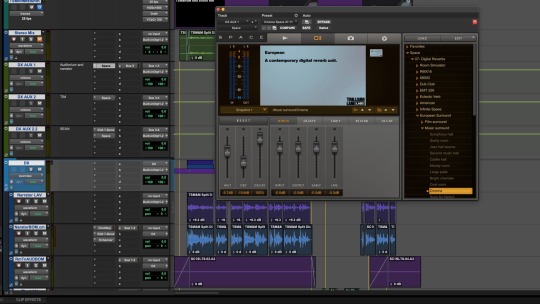
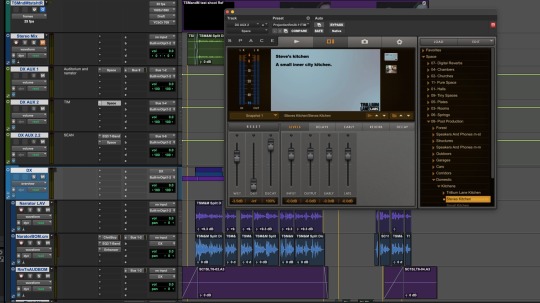
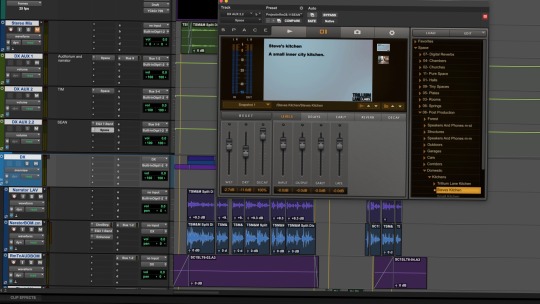
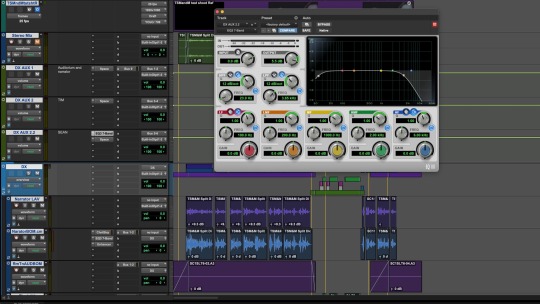
Once the dialogue was sorted, I moved on to creating a projector sound effect which would change depending on which room we were in. (Louder in the projection room, and panned to the left, quieter with less high and low frequencies in the auditorium.) I decided the sound should stay in stereo as it felt like a component of the atmos.
Then I needed to construct something to play from the cinema screen. I made an aux, routed dialogue to it so I had a temporary output to monitor and then added EQ and Space plug-ins to the track. I messed around with both plug-ins until I had a sound that mimicked the output of cinema speakers and I was pretty pleased with the outcome. The plug in settings are seen here.
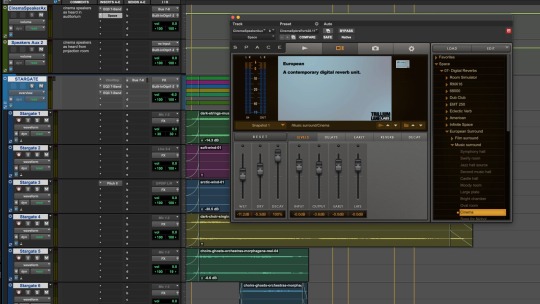
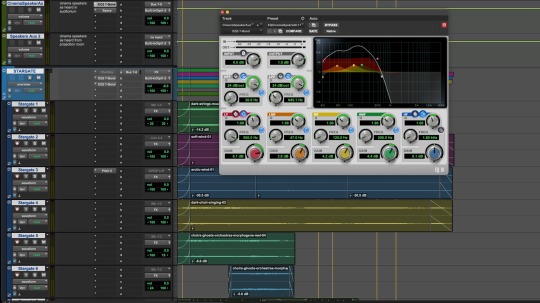
I took to Freesound to find some ominous sounds and choral singing to recreate my own version of the Star Gate sequence soundtrack. The finished thing is primarily made up of creepy strings and wind, manipulated with Pitch Shift. I then routed this through the Cinema Speakers Aux and it worked!! The effect was more obvious with dialogue but I still like the result.
I automated the Star Gate sounds to drop in volume and pan to the left as we move to the projection room. I also automated an EQ plug on the routing folder they were in, so the higher frequencies were lost as they ‘passed through the walls’ into this secondary space.
Earlier in the trimester I had planned that I wanted to make it sound like an old movie so I watched a video about ‘how to create a tape effect on digital sound’. The main takeaways: compress the hell out of it to emulate the reduced dynamic range, reduce the attack of the transients, EQ it to favour the mid frequencies and at some kind of saturation. This guy’s video was talking about music, but I assumed similar principles would apply. I had already read about the reduced dynamic range in old films so this seemed about right. I decided to apply these effects to The Narrator’s dialogue - mid frequency EQ, heavy compression, some fiddling with the Enhancer plug-in. I briefly tried to experiment with side chain compression to make the Star Gate sounds dip under his dialogue but it wasn’t working and I couldn’t figure out where I was going wrong. I thought this would have added to the vintage sound. It’ll have to be something I figure out in the new year.
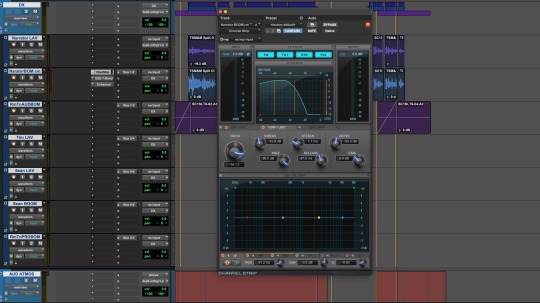
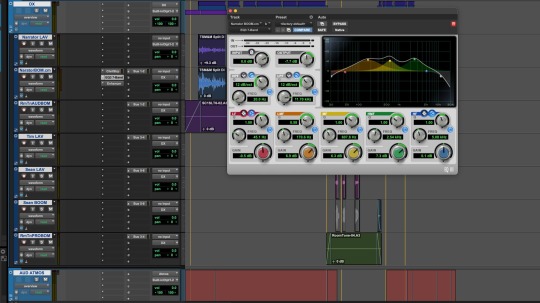
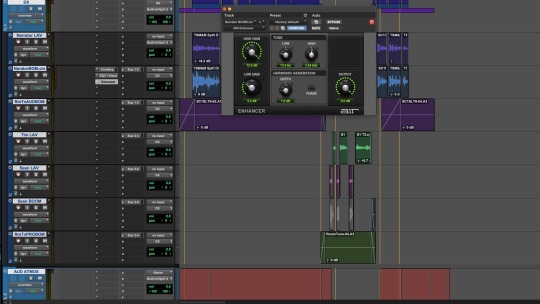
Robbie then came in to take a look at the sound edit. His main note was that the Star Gate sounds were creating the wrong tone. Upon listening again, I agreed.
We had this idea a lot earlier in the trimester to use a piece of music in the sound design. It was a simple guitar piece that Robbie had written and recorded on his phone; he’d used it in a sizzle reel for the project. It was definitely lighter in tone, a little bittersweet sounding perhaps, so I imported it and added it under the dialogue exchange and it kind of worked.
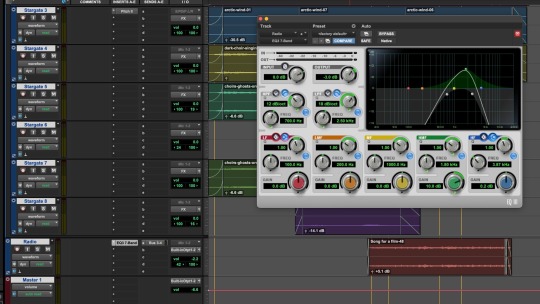
I wanted to make it sound somewhat diegetic at first so I added EQ to make it sound like it was coming from a old radio (above) and panned it to the right (other side from projector sound to balance it out). I then automated the EQ to get it back to normal, automated the pan to center and the volume to increase as the scene transitioned and The Narrator’s dialogue came back in. The song remains this way until the end of the film.
I think the result is maybe a little too sentimental but it definitely changed the tone for the better. The end result now much better represents the tone of the film I think we were aiming for. And I like how rough the song recording is. In fact I just really like the song. Music is such a manipulator! I kind of feel like I’ve cheated. Like I’ve brought emotions out of the audience that I haven’t earned.
1 note
·
View note
Text
KEEPER: Sound Design
I think I got too invested in AD-ing and all the prep that goes into just making the shoot happen, that forgot to properly consider the sound design. Also, balancing two projects in different stages of development has been quite tricky.
Essentially I didn’t get anywhere near enough wildtracks of the movement, enough voices or enough impacts. And I didn’t have time to foley it. Also the LAVs were way too close to peaking since the actors were yelling into them so they were unusable. The boom sound was mostly good thanks to Tom and Gaby so that was something at least. But I was constantly battling against the echoey space and terrible acoustics. (I’d noticed it on the day as soon as they started yelling but it had been too late to do anything about it by then.)
I should have been better prepared. I know I’ve had similar problems in the past where I don’t go in with a clear idea of what I need in the edit - where I can’t hear the edit yet so I can’t plan what I need to get. And so I inevitably don’t get enough wildtracks and then it makes it so much harder to design.
I don’t think I knew what the final result was going to sound like at all when I approached this. Or I just didn’t think about it. Anyway, it’s been a huge wake up call.
I’m really disappointed that none of the ideas I had planned came to fruition. I wasn’t able to foley impacts despite spending three days on the one minute scene. I didn’t record music because we couldn’t get the guy over in time and in hindsight, it just really wouldn’t have suited the tone anyway.
Looking forward to the real shoot, Ben and I are going to have a lot more discussions about sound, breakdown the script together in way more detail and make sure I have a clear understanding of the vision - and what this will sound like. I’m going to try and do a sound ‘paper edit’ to make sure I have it all mapped out and to highlight any gaps in my working.
I also want to make sure we have a proper tech recce before the shoot next year. When we come back in Jan, I plan to test the lavs with shouting to see what was going wrong on the test shoot. This being said I would still love to AD on set but it might have to be that I do this on a different project? I don’t want my secondary role to get in the way or convolute my primary role on the project, and at the minute I can’t guarantee that this won’t happen. If I can make sure it isn’t interfering at all next year then maybe I’ll AD on KEEPER. We’ll just have to see.
2 notes
·
View notes
Text
Tim, Sean, Mira and Mars: Test Shoot
@ Filmhouse Edinburgh, 22.11.23



We returned to the Filmhouse on the Wednesday of the same week to shoot. By this time we had narrowed it down to 4 shots and had secured an extra hour’s access in the morning. We had kit drop off that same day at 4:30 and had to be out of the Filmhouse by 4 anyway so there was no room to run over schedule. Taking pack up time and rush hour traffic into account, I aimed to have us wrapped by 2:30. My schedule is linked here, and my very rushed, very empty call sheet is here.


After a lot of horrible, vaguely traumatic incidents with Uber drivers (I’m now converted to Bolt) we managed to get the kit to the location. The crew gathered outside so that once we got access we could immediately start moving kit into the auditorium. We were using the back entrance to the Filmhouse so we didn’t need to worry about loitering around with kit as much - of course this would have been pretty much impossible from the front entrance on the main road.
Once inside the camera team started setting up the camera and the lights they needed for the first shot in the projection room, then moving each piece of kit up as and when it was needed. It was slightly inconvenient going up and down the many sets of stairs (two down, one up and vice versa) every single time but there just wasn’t room to store the kit anywhere else safely.
Jenny was very kindly recording sound for me in the morning so she got set up in the auditorium as well. The cast blocked the scene with Robbie while she got prepped. They stood in for camera and lighting checks, up in the projection room, and then I got them sent back down to Jenny to be mic-ed. During this time Jake also went on a couple runs to the shop across the road to grab last minute, in case-of-emergency batteries, snacks and a lot of water.
We basically used the auditorium as a base throughout the entire shoot. We were aware how small the projection room was but of course it felt even smaller once the camera and lights had been moved in. With all the electrics and just the number of bodies it started getting quite hot and there wasn’t much ventilation so I made sure no one was in the room unless they were needed, got lights and camera switched off when possible and kept crew to a minimum.
Jenny found it hard to boom in such a cramped environment and we kept getting boom shadow. Then some engineers started working in the room next door creating the occasional beep and muttering the occasional phrase - not ideal. It wasn’t ruining the dialogue per se but it would require some work in post.
I hope I’m not speaking incorrectly saying that I think Aimee would have liked a little longer to light. I was conscious of time and probably hurried her on a little too quickly. We only ran into lunch by 20 mins in the end and that was after Robbie sprang a whip pan shot on us out of nowhere. So perhaps there would have been more time to light. But in the moment you just don’t know what else might go wrong e.g more engineers show up, they get louder etc etc. I think making these judgement calls will just come with time.


Rosie Playford is Mira
In the afternoon we were shooting the split diopter shot in the auditorium. Alex Caldow was taking over sound from Jenny, and doubling up as gaffer, and I was sitting in as Mira. My starring role had been sprung on me and I had no choice but to reluctantly take it in my stride. Did wonders for the self esteem…..
Xander (The Narrator/the bald guy lurking behind me in the photo above) had a tongue twister of a speech to read out, approximately 50 seconds long so that obviously took a few takes. Then we shot my bit. The less said about that the better. The plan is to later stitch these shots together in the edit to create a split diopter effect.
There were a lot less things for me to think/worry about for the auditorium scene and we wrapped with plenty of time to get kit packed up. We even got time to grab stills of all the HoDs in the cinema seats (for the crowdfunder or the instagram or some kind of promotion purposes).

Photos by Ben McMorran
Thanks so much to everyone who gave their time and helped out! :))
2 notes
·
View notes
Text
AD-ing
(or, the reason I’m not sound recording)

Photo taken on set of Popper, dir. Bonnie Sanderson
I AD-ed on three projects this trimester: two of my own KEEPER and TSM&M, and one I’m not an HoD on, Popper, directed by Bonnie. I’ve talked briefly about my experiences on the former but I thought I’d dedicate a post to AD-ing in general as it’s something I’d like to continue to pursue.
I have a love/hate relationship with AD-ing. It’s one of the few types of on-set stress that I find manageable. I’m naturally quite a bossy person, I like organising other people even if I’m bad at it myself. I think it pushes me and continually teaches me how better to communicate with people. Comparing this year’s experience to Longboard Nights last year (when I also AD-ed with Ben as Director and Alex as DOP) I think I felt a lot more confident talking to people and shouting for quiet when we needed it this time around.
And yet every time I AD, it draws out the enemy of self-confidence - imposter syndrome. It’s especially bad on sets where I don’t know the team.
So, Popper. I should say, I loved being a part of this production. The sets Bonnie and Juno made were insanely cool. I wanted to be a part of making it as soon as I heard the idea! But it also terrified me. I’m not used to working with people out-with the course, and whenever I do I can’t help but focus on all the things I’m doing wrong, or even just the things I’m not doing perfectly. And that doesn’t get you anywhere. I don’t feel like I did a very good job AD-ing for Bonnie but I did enjoy being on set.
Going forward I’d really like to speak to other people who AD or maybe just watch someone else because I feel like I don’t really know what I’m doing well or what I could be doing better. I’m just listening to the voice in my head that tells me I’m bad at everything and that’s probably not the truth.
For the real shoots next year I’d like to AD on something but I’m not sure if I’ll maybe try and record the sound for my own sound design and then AD on other peoples’. More of that in the posts on sound design.
Anyway, Popper looks great! Can’t wait to see the results of the test shoot!
0 notes
Text
Tim, Sean, Mira and Mars Recce
Robbie managed to secure the Filmhouse as a shooting location!


Firstly, thank you so much to the Filmhouse! It was so cool to get to film in a real cinema. We hadn’t had any luck and it was getting so close to the deadline. We were looking for a auditorium and a projection room and they were kind enough to let us use both. And we’d barely have to set dress which was going to be a massive help considering we don’t have a dedicated production designer.

The Auditorium: spacious, not too many plug sockets (made a note to make more, hopefully pick one up from The Film Cult), no annoying hums that weren’t consistent, no outside noises! (The benefits of shooting in a room that is built specifically to keep outside sound out!)
The Projection Room: I can’t believe they let us in but they did. Very small, not a lot of space to move, made a mental note to keep crew to a minimum and to store kit in the auditorium, only bringing up what was necessary. Up a long flight of stairs, made a note to remind people to be careful. No annoying sounds, no external sounds, lots of practical light options and lots of interesting infrastructure which might occasionally create barriers between camera and actor but could also be used to frame/create leading lines. Also not many plug sockets, made sure to ask which ones we could use.
I left the recce feeling a lot more upbeat about the project. I knew Robbie had been struggling under the weight of writing, producing and directing so it was a huge relief that we were going to have a really good shooting location. And with easy access for picking up and dropping off kit.
Off the back of the recce I sat down with the shotlist Aimee had created and with Robbie’s help we began to schedule the shoot.
20.11.23
1 note
·
View note
Text
KEEPER: Test Shoot
@ Harrison Park, 16.11.23



Before even the recce Ben, Alex and I had a meeting to schedule the shoot day. After the recce we met again to make some adjustments. The schedule we agreed upon is linked here.
As 1st AD my job was to keep everything running, and if possible keep us on time. We didn’t get off to the best start: kit transport was taking longer than we’d hoped and then to top it off we very nearly lost the location less than an hour before we were due to start shooting. Luckily, Lucy (Best Producer) Gilmore managed to convince them otherwise!
My job was easy enough. I fumbled the meeting at the start. (Ben likes to gather the cast and crew for a meeting at the start of every shoot day to get on the same page. As a team we’ve adopted it as best practice.) We’ve since reflected on the shoot and decided that I’ll delegate this meeting to Lucy since I hate the public speaking aspect. Instead I’m planning to have individual meetings with each department at the start of the day to get an idea of what time they need to set up, and any other info I might need or might need to pass on.
We occasionally ran behind but easily found the time later and finished slightly ahead of schedule. This allowed us more time to get wildtracks for sound at the end.
[Also I enjoyed waddling round with my iPad like a kid]




I think our main issue on the day (after the location debacle) was the constantly changing weather - from overcast to sunny to raining. And the mud. There was a lot of mud. Alex was annoyed by his lack of control over the light and we deliberated waiting for the sun to go behind the clouds a couple times but in the end it was just so changeable that we had to keep going.
Ben later remarked that he and Alex barely spoke and yet the production kept moving. He was able to focus on cast without worrying about the minutiae of what camera, sound or production design were doing. So apparently I’m doing something right? In his eyes at least.
I think I just need to keep this communication going even more but it’s a fine line to walk between micromanaging and pestering or ‘moving the production forward’. And I’m always keen to avoid panicking the crew with the time limit because it’ll only make them work sloppier and more dangerously. I much prefer asking them how long they need and keeping an open dialogue. Anyway, I’m reflecting more on AD-ing as a whole in a later post.


The fact it ran so smoothly is down to Lucy and her production team - Eilis, Jack, Rachel, Monica - as well as everyone else that came along to help out - Claire, Kushal, Niamh, Sam, Gaby, Tom, Alyssa, Orla, Mary and Alex. A Ben McMorran production is always a powerhouse - in fact he has a reputation for stealing every crew member available - but I think it’s a testament to this group that so many others are willing to lending a hand.
Thanks also goes out to the cast and the supporting actors, especially Lewis and Findlay who continually threw themselves onto the ground in the name of our test shoot.
[Photos by Orla and Eilis]
3 notes
·
View notes